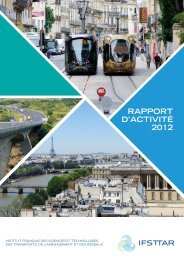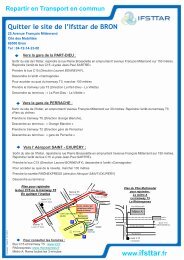french institute of science and technology for transport ... - Ifsttar
french institute of science and technology for transport ... - Ifsttar
french institute of science and technology for transport ... - Ifsttar
You also want an ePaper? Increase the reach of your titles
YUMPU automatically turns print PDFs into web optimized ePapers that Google loves.
Research orientation 3_Accident analyses, biomechanics, health<br />
Finite element modelling<br />
Pregnant women <strong>and</strong> children first<br />
The LBA has been investigating the protection <strong>of</strong><br />
pregnant women <strong>and</strong> children in the event <strong>of</strong> a car crash<br />
<strong>for</strong> almost 8 years, in close collaboration with the Nice<br />
<strong>and</strong> Marseille welfare services.<br />
The defence <strong>of</strong> the doctoral theses by François<br />
Coulangeat (1) <strong>and</strong> Jérémie Pérès (2) had a considerable impact<br />
on this topic in 2011. Both studies developed detailed finite<br />
element models <strong>for</strong> assessing the vulnerability <strong>of</strong> these groups<br />
<strong>of</strong> users <strong>and</strong> proposing new protection devices.<br />
With regard to pregnant women, the recent advances have<br />
identified new injury criteria that are backed up by the available<br />
epidemiological data. In particular, these criteria are based on<br />
fluid-structure coupling that provides accurate modelling <strong>of</strong> the<br />
interactions between the uterus, the placenta <strong>and</strong> the foetus<br />
within the amniotic fluid.<br />
By simulating a variety <strong>of</strong> impacts, the influence <strong>of</strong> the<br />
adjustments that are available in the passenger compartment<br />
(position <strong>of</strong> the seat <strong>and</strong> steering wheel) on the unborn child’s<br />
fatality risk was assessed <strong>and</strong> should provide the basis <strong>for</strong><br />
recommendations that are based on more objective observations.<br />
(1) A finite element numerical model <strong>of</strong> a child.<br />
(2) Injury mechanisms in pregnant women <strong>and</strong> their foetus during a road<br />
traffic accident.<br />
Numerical models dealing with the protection <strong>of</strong> pregnant<br />
women <strong>and</strong> children.<br />
This model means we can now envisage optimizing restraint<br />
systems. The development <strong>of</strong> a comprehensive bio-faithful<br />
numerical model <strong>of</strong> a six year-old child, the first <strong>of</strong> its type, was<br />
finalized by the reconstruction <strong>of</strong> a real crash, in partnership<br />
with the Accident Mechanisms Unit.<br />
@ CONTACT<br />
michel.behr@ifsttar.fr<br />
Modelling the abdomen<br />
65<br />
The first phase <strong>of</strong> the projects conducted by the Global<br />
Human Body Modelling Consortium (GHBMC) is drawing<br />
to a close. Its goal was to create the first complete model<br />
<strong>of</strong> a human being that was as bio-faithful as possible.<br />
This ambitious programme was launched in 2008<br />
with funding from a global consortium consisting <strong>of</strong> 8 vehicle<br />
manufacturers, one subcontractor <strong>and</strong> NHTSA (the American<br />
National Highway Traffic Safety Agency). The GHBMC has entrusted<br />
the various topics to six centres <strong>of</strong> academic expertise:<br />
Wake Forest University <strong>for</strong> geometry <strong>and</strong> assembly, Wayne<br />
State University <strong>for</strong> the head, Waterloo University <strong>for</strong> the neck,<br />
University <strong>of</strong> Virginia <strong>for</strong> the thorax, University <strong>of</strong> Virginia with<br />
the University <strong>of</strong> Alabama in Birmingham <strong>for</strong> the lower limb<br />
<strong>and</strong> IFSTTAR with Virginia Tech <strong>for</strong> the abdomen (LBMC<br />
modelled the abdomen, while Virginia Tech carried out the<br />
experimental work).<br />
LBMC’s part <strong>of</strong> the work follows on from a doctoral<br />
thesis on abdominal modelling (with Lab<br />
PSARenault) <strong>and</strong> another on the characterization<br />
<strong>of</strong> liver tissue (with the INSA in Lyon). The<br />
abdomen develop by LBMC was validated under<br />
12 impact configurations <strong>and</strong> the first injury<br />
criteria were proposed <strong>for</strong> the liver <strong>and</strong><br />
spleen. Validation work will continue using<br />
data on the kinematics <strong>of</strong> internal<br />
organs obtained by Virginia Tech.<br />
The model has been tested<br />
in full or in part under more<br />
than 60 impact conditions,<br />
<strong>and</strong> injury criteria have been<br />
proposed <strong>for</strong> most anatomical<br />
regions.<br />
This model is intended to become the reference<br />
human model in the industrial <strong>and</strong> academic sectors <strong>for</strong> improving<br />
safety. Research is due to continue, amongst other<br />
things to create models that represent other groups.<br />
@ CONTACT<br />
philippe.beillas@ifsttar.fr<br />
Lhe GHBMC 50 th percentile model <strong>for</strong> a man (Phase 1)<br />
contains approximately 2 million elements. It has been<br />
tested under more than 60 impact conditions. The LBMC<br />
was responsible <strong>for</strong> modelling the abdomen.<br />
ANNUAL REPORT 2011 ifsttar.fr






![Trajectoire le magazine n°3 - Juillet 2012 [.pdf] - Ifsttar](https://img.yumpu.com/30038493/1/190x253/trajectoire-le-magazine-na3-juillet-2012-pdf-ifsttar.jpg?quality=85)

